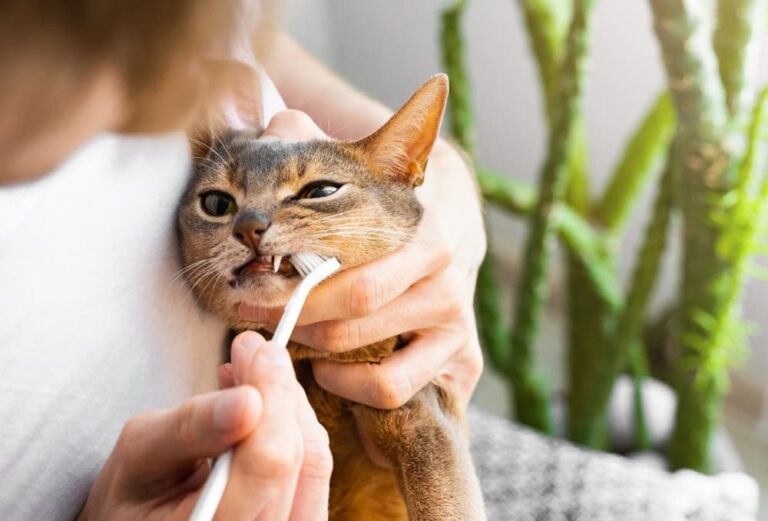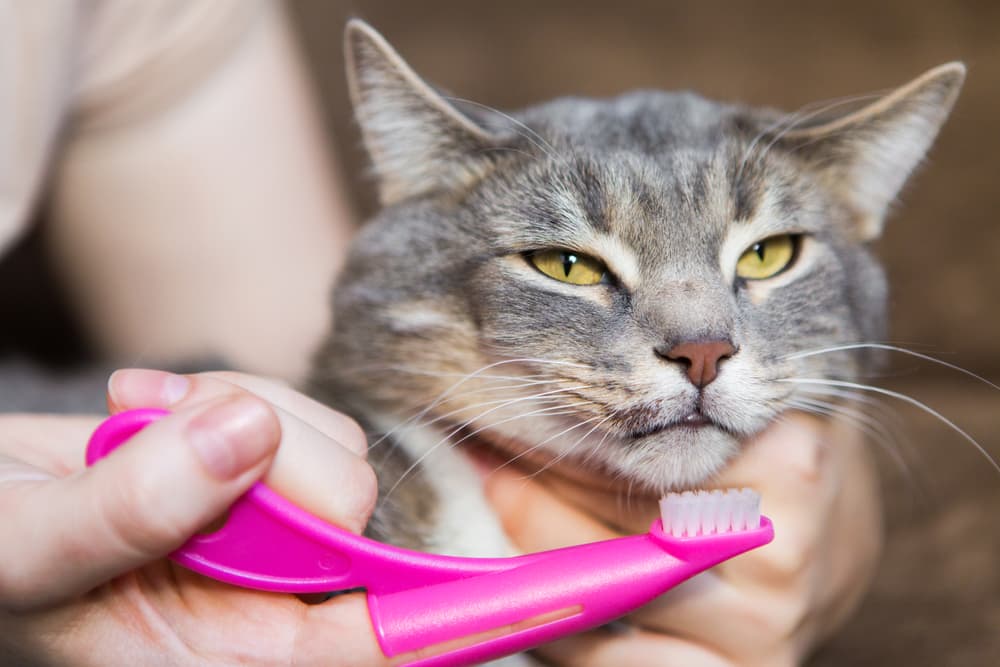How to Brush a Cat’s Teeth: Steps and Tips

Overview
- Oral hygiene can help prevent the most common forms of dental diseases in cats.
- With the proper preparation, most cats will allow you to brush their teeth without much fuss.
- Practice touching your cat's mouth and familiarizing them with the idea of brushing before diving in.
- You'll need a cat toothbrush and cat-specific toothpaste to brush your cat's teeth.
- Daily brushing is ideal, but a few times a week can also be beneficial.
- Remember to schedule regular checkups for your cat, even if you're meticulous about brushing.
Cats are renowned for their meticulous grooming habits and impeccable cleanliness, but there’s one crucial personal care task they simply can’t perform on their own: brushing their teeth.
Just as with humans, our feline friends are vulnerable to diseases of the teeth and gums. In fact, studies report that between 50 and 90 percent of cats older than 4 years old experience some form of dental disease (1).
Fortunately, proper dental hygiene can go a long way in preventing the most common forms of these diseases. But it’s up to us as pet parents to ensure it gets done, and it can be tricky to understand exactly how to brush a cat’s teeth.
If the thought of sticking a toothbrush into your kitty’s fanged mouth sounds like a daunting task, you’re not alone. It certainly can be, especially if they aren’t used to mouth handling or tooth-brushing procedures. The good news? With the right approach, most cats will eventually allow you to brush their chompers without much fuss.
Keep reading to learn how to safely, easily, and effectively brush your cat’s teeth at home.
Benefits of Brushing a Cat’s Teeth
Before we get into how to brush a cat’s teeth, let’s review why cat teeth cleaning is so important. As with human teeth, cat teeth need brushing to keep them clean and healthy.
“Brushing teeth removes plaque, an invisible, thin layer of bacteria and other material,” says Dr. Patrik Holmboe, head veterinarian at Cooper Pet Care. “Left untouched, plaque eventually calcifies into tartar, a rock-hard, brown material that sticks to the teeth and is much harder to remove.”
Dr. Holmboe explains that tartar not only looks unsightly, but it’s also chock-full of bacteria — and if not removed, it can greatly increase the likelihood of more advanced dental diseases like gingivitis and periodontitis. Once your cat reaches the stage of periodontitis, they face a high risk of bacterial infection in the tooth roots and bone surrounding the teeth, opening the door to loose or lost teeth, gum disease, difficulty eating, pain, and infection that spreads elsewhere in the body.
Although tartar build-up on your cat’s teeth requires removal by a veterinarian under general anesthesia, regular dental cleaning at home can remove plaque. Removing this plaque before it hardens into tartar is an essential part of home dental care.
Added bonuses of regular brushing include helping your cat get accustomed to being handled and keeping their breath smelling fresh (or at least fresher!).
How to Brush a Cat’s Teeth: Preparation and Training
Attempting to immediately brush your cat’s teeth without acclimating them to the process is a surefire recipe for failure (and likely a few scratches). To increase your chances of success, it’s crucial to get your cat comfortable with the idea. Here are a few ways to prep your feline friend for brushing:
Start by getting your cat used to being touched around the mouth. When petting your cat throughout the day, as you normally do, work your way over to their mouth and gently rub your finger around their teeth, gums, and jawline. Give them lots of praise during and after.
Next, introduce your cat to the sensation of brushing with a tantalizing treat: tuna water. While it doesn’t provide any dental benefits, most cats love the taste of tuna water, which helps create a positive association. Before busting out the toothpaste, Covetrus recommends dipping your finger in tuna water and offering it to your cat. Once you’re done, praise your kitty and reward them with a treat.
Then, graduate to warm-up lessons with actual cat toothpaste. Choose a time when your cat is relaxed and let them sniff and lick some cat toothpaste off your finger. Unlike human toothpaste, which is typically mint flavored, cat toothpaste has a beef, fish, or poultry flavor, so it’s usually enticing. As they lick the paste, begin to rub your finger lightly along their teeth to simulate brushing. To make them feel more comfortable, give them some gentle scratches around their head and under their jaw as you go.
To ensure your cat is at ease with the process, it may be necessary to practice this warm-up lesson multiple times before progressing to the main event.
Supplies for Brushing Your Cat’s Teeth

Once you feel your cat is comfortable with the idea of brushing, it’s time to transition to the real deal.
Here are the supplies you’ll need:
- A specially formulated cat toothpaste. Ensure the toothpaste you choose is labeled as safe for feline use. Cat toothpaste is safe for cats to swallow and contains enzymes that clean their teeth. Do not use human toothpaste, as it contains ingredients (like fluoride and artificial sweeteners) that can be harmful to cats. In a pinch, Dr. Amanda Skinner, DVM, at Sunset Vet Clinic says that even just taking a dry toothbrush to your cat’s teeth can be beneficial.
- A cat-specific toothbrush. A cat toothbrush has special features designed for brushing their teeth, including a small size and an angled handle. Finger toothbrushes, which fit over the tip of your finger, are another option. For some cats, using a very soft toothbrush designed for human babies is acceptable.
Steps for Brushing a Cat’s Teeth
Now that you understand the “why” behind cat tooth brushing and know what supplies you’ll need, let’s review the steps for how to effectively clean your cat’s teeth.
- Squeeze a small amount of toothpaste onto a cat-friendly toothbrush and place it aside.
- Kneel down and position your cat between your legs, with their head facing away from you. This will prevent them from backing away.
- Tilt your cat’s head upward at a slight angle and raise their lip.
- Gently move the toothbrush or finger brush in circles across the teeth near the gumline. Work front to back on one side. This should take about 30 seconds. Talk to your cat in a soft voice while brushing to reassure them.
- Switch sides and repeat.
If you can’t brush your cat’s teeth for the full minute on the first attempt, don’t worry. Just brush as long as you can before they really let you know they want to be done. This might only be five seconds to start, but that’s better than nothing, and you can gradually increase the time each day as they get used to it.
A daily brushing session is ideal for most cats, though brushing even just once or twice a week may offer some benefit. “Less than this, and the actual effectiveness of the brushing is probably pretty low,” says Dr. Holmboe.
Tips for Successful Tooth Brushing and Dental Health in Cats

Here are some tips to help ensure cat tooth brushing success:
Start when they are young
Dr. Holmboe suggests starting your brushing sessions when your cat is 6 to 12 months old. “At 6 months, usually all the permanent teeth have erupted,” he says. “And this is a good age period where a young cat is still very accepting of new things.”
Select a specific time
Cats respond well to routine, so be consistent with the time you brush their teeth every day. Pick a time of day that is generally quiet.
Use a toothpaste they like
Cat toothpaste comes in different flavors, so find one your cat approves of. You can test it by putting a little on your finger and seeing if they lick it off.
Find a quiet area
In order to help your cat feel relaxed and comfortable, find a peaceful place away from the hustle and bustle for your brushing sessions.
Create positive associations
After brushing, immediately give your cat their favorite treat and lots of love for a job well done. This will help them associate brushing with good things, thereby increasing their willingness to participate in future sessions.
Be mindful of your demeanor
Your cat will sense if you’re anxious and respond accordingly. To increase the chances of keeping them calm, try to maintain a relaxed, positive attitude and demeanor during the sessions.
Be patient
It’s important not to force brushing sessions, as this will create a negative association, so pay attention to your cat’s cues. If they are really fussy and struggling to get away, stop and try again the next day.
Supplement with dental care products
Dental health products, such as dental treats and water additives, can be helpful, but Dr. Holmboe warns that they’re not a replacement for tooth brushing. The exception, he says, is scientifically-formulated dental kibble, which can be an effective long-term tooth-brushing replacement.
Watch for warning signs
Even with regular brushing, it’s still possible for dental problems to develop. That’s why it’s important to be on the lookout for signs of dental disease in your cat, especially if they are older.
Common signs include dropping food while eating, vocalizing while eating, drooling, blood in the mouth, or changes in eating behavior, says Dr. Holmboe. “Even more serious signs might include weight loss and lethargy.” If you notice any of these signs, a visit to your veterinarian is in order.
Get regular checkups
Regardless of how meticulous you are with brushing, Dr. Skinner says it’s important to get your cat’s teeth checked every six months to one year by your veterinarian. They can assess if your kitty needs a professional dental cleaning.
By making dental care a part of your cat’s routine and giving their pearly whites some regular TLC, you can help ensure they have healthy teeth and gums for years to come.
References
- Cornell Feline Health Center. “Feline Dental Disease.” Updated June 2017. Retrieved from https://www.vet.cornell.edu/departments-centers-and-institutes/cornell-feline-health-center/health-information/feline-health-topics/feline-dental-disease









